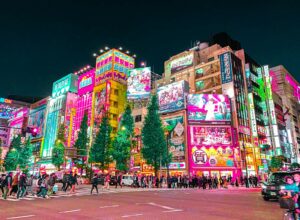In the vast expanse of cultural exports that have defined modern Japan, manga stands out as a quintessential and dynamic art form that has captivated hearts and imaginations across the globe. This illustrated narrative medium, with its unique blend of storytelling, art, and cultural nuances, has transcended its origins to become a global phenomenon. From the bustling streets of Tokyo to bookshelves and digital screens worldwide, manga’s journey from a niche Japanese comic form to an international cultural cornerstone is a tale of creativity, resilience, and universal appeal. As we delve into the world of manga, we uncover the layers that have made it a pivotal part of contemporary pop culture and a significant contributor to the global cultural economy.
1. The Rise of Manga: Japan’s Cultural Export
Manga, often perceived as the lifeblood of Japanese pop culture, has evolved significantly since its post-World War II resurgence. Initially a form of cheap entertainment, it has grown in sophistication and variety, mirroring Japan’s societal changes and challenges. The international fascination with manga can be attributed to its unique storytelling style, diverse genres, and deep emotional connections established with readers. Manga’s accessibility has been a key factor in its rise, offering stories for all ages and interests, thereby cementing its place as a cultural export of immense value. The government of Japan has recognized manga as a vital tool for cultural diplomacy, utilizing it to showcase Japanese culture and values globally. As manga artists, or mangakas, continue to push the boundaries of this art form, its international footprint expands, making it an undeniable pillar of Japan’s cultural export.
2. From Comics to Global Phenomenon: The Manga Journey
Manga’s transformation from comics read by a domestic audience to a global phenomenon is a narrative of cultural exchange and digital evolution. The international journey of manga began in earnest in the 1980s and 1990s, with titles like "Akira" and "Dragon Ball" leading the charge, breaking through cultural and linguistic barriers. The proliferation of anime, manga’s animated counterpart, further propelled manga onto the global stage, creating a synergistic relationship that introduced these stories to a broader audience. Publishers and translators began to work diligently to make manga available and accessible worldwide, leading to its explosive popularity in countries far from its Japanese origins. Bookstores and libraries across the world now have dedicated manga sections, a testament to its enduring appeal and significance. The digital age has further democratized access to manga, allowing for instantaneous consumption and fostering a more inclusive global manga community.
3. Manga Mania: How Japan Conquered the World
The global conquest of manga is a testament to its universal themes and versatile storytelling. Manga mania has taken the world by storm, with fan conventions, cosplay events, and manga cafes emerging in cities far from Japan. This cultural wave has not only introduced global audiences to the intricate art of manga but has also fostered a deep appreciation for Japanese culture and traditions. Educational institutions have begun incorporating manga into their curricula to teach language and cultural studies, highlighting its educational value. The phenomenon has transcended mere entertainment, becoming a bridge between diverse cultures and fostering a global community united by their love for manga. This widespread enthusiasm has led to manga influencing international comic artists and writers, showcasing its impact on global pop culture and creative industries.
4. The Art and Heart of Manga: A Deep Dive
Manga is more than just reading material; it’s an immersive experience that combines art, storytelling, and cultural depth. The art style of manga, characterized by its expressive characters and dynamic scenes, plays a crucial role in conveying emotional depth and narrative complexity. This visual storytelling, coupled with culturally rich narratives, allows readers to explore themes of love, loss, struggle, and triumph. Manga artists employ a wide range of techniques, from delicate line work to dramatic shading, to bring their stories to life, making each page a work of art. The heart of manga lies in its ability to connect with readers on a personal level, addressing universal issues through the lens of Japanese culture and society. It is this unique combination of art and heart that has endeared manga to millions of fans worldwide.
5. Transcending Borders: Manga’s International Appeal
Manga’s international appeal lies in its remarkable ability to transcend cultural and linguistic borders. Its wide range of genres, from action and adventure to romance, horror, and slice of life, ensures there is something for every reader. Manga’s storytelling techniques, which often include silent panels and visual metaphors, allow for a form of storytelling that is less reliant on language, making it more accessible to a global audience. Furthermore, the themes explored in manga often touch on universal experiences and emotions, making it easy for readers from different cultural backgrounds to relate to the characters and their journeys. The global manga community is a testament to its international appeal, with fans coming together online and in person to share their love for these stories. As manga continues to cross cultural and linguistic barriers, it brings together people from all walks of life, united by their love for this unique form of storytelling.
6. Manga in Mainstream Media: From Niche to Norm
The integration of manga into mainstream media is a reflection of its widespread popularity and cultural significance. Once considered a niche interest outside of Japan, manga has now found its way into mainstream consciousness, influencing movies, television shows, and even fashion. Hollywood adaptations of popular manga and anime series, though met with mixed reactions, highlight the global entertainment industry’s recognition of manga’s appeal and market potential. The inclusion of manga-related content in major newspapers, magazines, and online platforms further underscores its move from the fringes to the forefront of popular culture. Educational systems around the world are recognizing the value of manga as a teaching tool, further solidifying its place in mainstream media. As manga continues to break down barriers and challenge the norms of traditional media, its influence on global pop culture is undeniable.
The story of manga, from its humble beginnings to its status as a global cultural phenomenon, is a testament to the power of storytelling and the universal appeal of its art. As manga continues to evolve and adapt to the changing landscape of media and entertainment, its impact on global culture and economy is undeniable. With advancements in digital technology and a growing international fan base, the future of manga looks bright, promising new stories, innovative art, and continued global influence. The manga phenomenon, with its diverse genres, universal themes, and passionate fandom, stands as a shining example of how creativity and culture can bridge divides, connect worlds, and enrich the global cultural tapestry. As we look ahead, manga’s journey from a Japanese cultural export to a global cultural phenomenon continues to unfold, promising to captivate and inspire generations to come.








